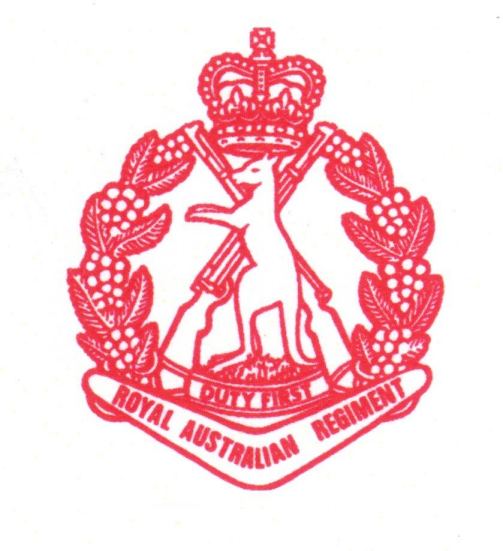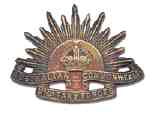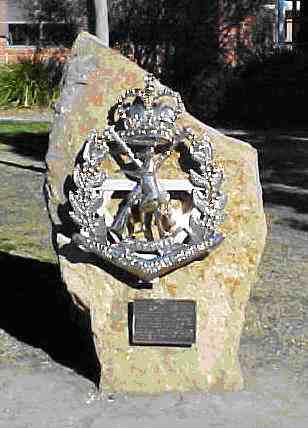
PART 1 – In The Beginning
BRIEF HISTORY OF
THE FOURTH BATTALION OF THE ROYAL AUSTRALIAN REGIMENT (4 RAR)
End of World War II
In May 1945 when the Japanese were nearing the point where defeat was inevitable, the Australian Government decided (to raise a Brigade Group based on three (3) Infantry Battalions from Australian Divisions serving overseas.) that a force would be raised of volunteers from the Infantry Divisions then in operations against the enemy as part of an Occupational Force in Japan. At the cessation of hostilities the 9th Division was then in Borneo and on the call for volunteers for this force, those from the 9th Division congregated on the island of Morotai in a newly formed battalion, the 66th Australian Infantry Battalion, later to become 2 RAR.
Joining them to become 34th Brigade were volunteers from the 7th Division to form the 65th Australian Infantry Battalion, later to become 1 RAR. Volunteers from 3rd, 6th, and 11th Division formed the 67th Australian Infantry Battalion, later to become 3 RAR. 65th Australian Infantry Battalion was formed from the 7th Division in Balikipapan on 12th October 1945. 66th Australian Infantry Battalion was formed from the 9th Division in Tarakan, Borneo on 14th October 1945. 67th Australian Infantry Battalion was formed from the 6th Division in Papua New Guinea (PNG) and the 3rd and 5th Division in Bougainville on 20th October 1945.

Rising Sun Hat badge worn prior to the RAR badge being issued in 1954
A number of alternatives were prepared 1, 2 and 3 RAR had originally been raised as the 65th, 66th and 67th Infantry Battalions at the end of World War II on Morotai - an island in eastern Indonesia - for the British Commonwealth Occupation Force in Japan. In November 1945 all units moved to the island of Morotai, an island which is now Maluka in Indonesia and came under command of HQ 34 Australian Infantry Brigade.
After much waiting the 34th Brigade was to arrive in Japan in January 1946 to take up occupation duties in the Hiroshima prefecture.
The basis of the post-war regular army accepted in 1947 was the infantry brigade then located in Japan. When the decision was taken to withdraw two of the battalions in 1948, attention turned to the status and designation of the Australian Regular Army (ARA) battalions. Brigadier Hopkins was concerned that despite the unit prestige and regimental spirit developed since October 1945, it would be undesirable to have the ARA units the highest numbered, without battle honours or colours, and with precedence after militia units. He recommended the adoption of designation of Citizens Military Forces (CMF) units that had not been raised when the CMF was reformed. It was therefore proposed that the 65th Battalion be designated the 1st Infantry Battalion, City of Sydney's Own Regiment; the 66th Battalion, the 1st Infantry Battalion, Royal Melbourne Regiment; and the 67th Battalion, the 1st Infantry Battalion, The Oxley Regiment.
An alternative proposal was submitted by the infantry cell within the Directorate of Staff Duties (the predecessor of the Directorate of Infantry). It was suggested that the 65th Battalion become the 1st Battalion, King George VI's Australian Rifle Regiment; the 66th Battalion the 1st Battalion, Queen Elizabeth's Australian Footguards; and the 67th Battalion the 1st Battalion, Princess Margaret's Australian Infantry Regiment.
Ultimately it was decided to adopt a regimental system, along the lines of the British Army, and the existing units were to be numbered sequentially as a part of one regiment. The three battalions in Japan were designated the 1st, 2nd and 3rd Battalions of the Australian Regiment (AR) with application made for a royal title. This designation was approved by the Minister and took effect on 23 November 1948. The prefix 'Royal' was granted by His Majesty King George VI, and was announced on 10 March 1949. The Royal Australian Regiment thus came into being as Australia's first regular regiment of the infantry. Regimental colours were subsequently presented to the battalions and in accordance with the new status the Regiment did not adopt any existing battle honours. The Regiment now had the task of establishing its own traditions and was very soon to win its own honours.
The design of the regimental badge was selected from a number of suggestions considered by the Director of Infantry, Brigadier I.R. Campbell in early 1949. The design was drawn up by Sergeant E.J. O'Sullivan of 1 RAR Intelligence Section and had originally been intended for 1 RAR only. The design featured the kangaroo and wattle wreath as distinctly Australian symbols; the boomerang, which had been used in the tactical signs of the 2nd AIF from which the original units of 34 Brigade were raised; the crossed rifles signifying the personal weapon of the infantryman; and the crown because of the royal title of the Regiment. The simply but highly appropriate motto 'Duty First' was suggested by Major K.B. Thomas MC of 1 RAR. This motto was adopted and included on the badge. Although the badge was reproduced on Christmas cards in 1949, it was not until early 1954 that the hat badge was issued to replace the rising sun badge.
Introduction – The “Old” 4 RAR
The first unit to bear the title “4th Battalion, The Royal Australian Regiment” was raised in 1952.
On 18 January 1952, a unit known initially as the Royal Australian Regiment Depot was raised at Ingleburn to train and hold Infantrymen for service in Korea. At this time, the Australian Army had only three regular Infantry battalions. 3 RAR was engaged in operations in Korea and 1 RAR was deploying to Korea to double the Australian commitment there. 2 RAR had also been warned for service in Korea and this battalion was unable to train individual replacements for the two battalions in Korea and at the same time conduct battalion level training to prepare itself for operations there. To see the nominal roll of the original 4 RAR Depot Coy click here: Original Roll
On 10 March 1952, the Royal Australian Regiment Depot was renamed the 4th Battalion, The Royal Australian Regiment. This renaming was necessary as the Government had given approval to raise a fourth battalion and not a regimental depot. In the event, 4 RAR performed the function of a regimental depot conducting the Infantry corps training of personnel destined for Korea and later Malaya. Despite its new name, it was recognised that 4 RAR was not a line battalion. It had a permanent staff of only about 40 personnel although several thousand Infantrymen passed through it during the eight years it existed on the Order of Battle, meaning the military’s organisational structure.

The gate badge of 4 RAR Depot which is now on display at Infantry Centre, Singleton
On 24 March 1960, the “old 4 RAR” was re-designated “Depot Company, The Royal Australian Regiment” and incorporated with the School of Infantry to form the new Infantry Centre which at this time was located at Ingleburn. (The Infantry Centre re-located to Singleton New South Wales in 1973.)
ORIGINAL ROLL FROM DEPOT COMPANY